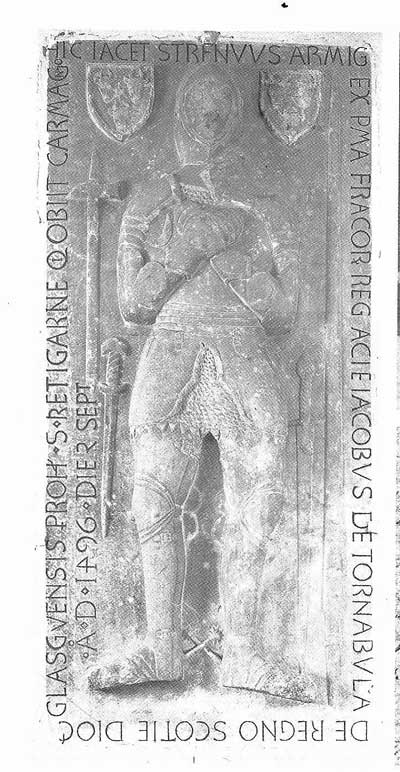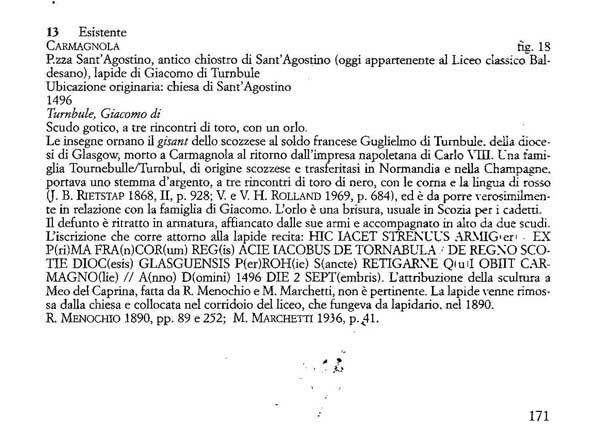Written by Angelo Arata


In the town of Carmagnola, Piedmont, Italy there is an engraved tombstone of James of Turnbull. He was an armiger, a man-at-arms, who followed King Charles VIII in the expedition to Naples. He died in Carmagnola in 1496, possibly be from injuries received during the battle of Fornovo (6 July 1495).
The text of the scheda (fiche or information document): in red my clarifications.
13 Existent [i.e. monument]
CARMAGNOLA [the town in which is the monument]
Saint Augustine Square, ancient cloister of Saint Augustine (today belonging to Liceo classico Baldesano [it is a classical high school or lycee]), tombstone of Giacomo di Turnbule [James of Turnbull]
Original location: Saint Augustine's Church
1496
Turnbule, Giacomo di
Gothic shield, three heads of bull, with an orle
The insignia decorate the gisant [i.e. recumbent effigy] of the Scotsman in the pay of French Giacomo di Turnbule, from the Glasgow diocese, died in Carmagnola returning from the Neapolitan emprise of Charles VIII. A Tounebulle/Turnbul family, of scottish ancestry and moved to Normandy e to Champagne, bore a coat of arms argent, three bulls' heads sable [i.e. black], with gules [red] horns and tongues (J.B. RIETSTAP 1868, II, p. 928; V. e V.H. ROLLAND 1969, P. 684), and is most likely to relate to James' family. The orle is a brisure [mark of cadency], in Scotland an usual way of distinguishing the cadets.
The dead is portrayed in armour, flancked by his weapons and accompanied by two shields.
The inscription carved into the edge of the tombstone recites: HIC IACET STRENUUS ARMIG(ier)/ EX P(ri)MA FRA(n)COR(um) REG(is) ACIE IACOBUS DE TORNABULA/DE REGNO SCOTIE DIOC(esis) GLASGUENSIS P(er)ROH(ie) S(ancte) RETIGARNE. Q(u)I OBIIT CARMAGNO(lie)//A(nno) D(omini) 1496 DIE 2 SEPT(embris). The attribution of the sculpture to Meo da Caprina, maked by R. Menochio and M. Marchetti, isn't pertinent. The tombstone was removed from the church and placed in the hallway of the lycee, that functioned as a epigraphic museum, in 1890.
R. MENOCHIO 1890, pp. 89 and 252; M. MARCHETTI 1936, P. 41.
- 1.The documents was derived from: L.C. Gentile, Araldica saluzzese. Il Medioevo, Cuneo, 2004 picture: n. 18, p. 48, scheda: p. 171
I may add that In Middle ages many Scots came to the aid the Kings of France and Scottish soldiers also served in the Garde Écossaise, the loyal bodyguard of the French monarchy. Many Scottish mercenaries chose to settle in France. Some were granted lands and titles in France. In the 15th and 16th centuries, they became naturalised French subjects (see Bonner, Elizabeth (2002)."Scotland's `Auld Alliance' with France, 1295-1560" and French Naturalization of the Scots in the Fifteenth and Sixteenth Centuries by Elizabeth Bonner
In James Turnball's case I think that the soldier was in the Scottish troops under the command ofRobertson of Strowan, who fought forCharles VIII in Italy (some Italian families claim descent from them). Several of the highest families in Scotland devoted themselves to the French service, and rose high in favour and influence: John Stewart of Darnly was Constable of the Scots in France, and the French King in 1424 made him Lord of Aubigny, afterwards giving him the county of Dreux, and making him a Marshal of France. His descendants, John, Robert, Bernard or Berald, and others, served their adopted country well and faithfully, under Charles VIII., Louis XII., and following sovereigns, in the wars of Italy, where they particularly distinguished themselves at the battle of Fornovo, as well as in the Kingdom of Naples; and in 1495 the then lord was made Governor of Calabria by Charles VIII.
In the battle of Fornovo this èlite Royal guard was very important and the Scottish infantry archers gave a relevant contribute. Nevertheless, Giacomo di Turnbule's effigy shows a typical warrior in full armour such as those worn by the best-equipped men-at-arms heavy cavalry in the second half of the 15th century. May be he was a captain of the archers, but his armour and weapons are distinctive of a knight: spurs, sword, pole-axe (a sort of warhammer or martello d'arme in Italian), dagger, lance.
It is possible that James of Turnbull was injured during the battle of Fornovo, on 6 July 1495; Charles VIII's army, after the fight, rested for the rest of the day, then marched north during the night, reaching the relative safety of Asti on 15 July and after went to Turin and from here to France on 22 october. But it is also possible that James was wounded in the fighting after the battle or aquiring a serious disease (the Duke of Orleans was besieged in Novara, where the French suffered famine and misery). In fact, he died on 2 september 1496, more than an year after the battle of Fornovo, and it is improbable that his agony lasted 14 months. On the other hand, if it was healthy when Charles VIII returned in France, he would get back with the army. Therefore, the reasons of his death remain unresolved! We can only say that he was buried in Carmagnola because the little town belonged to Ludovico II, Marquess of Saluzzo and trusty vassal of the King of France.

































.jpeg#joomlaImage://local-images/tcalibrary/museum/vmpeople/John%20I%20Turnbull%20(Jack).jpeg?width=960&height=1169)







.jpg#joomlaImage://local-images/tcalibrary/museum/vmpeople/Malcolm_Turnbull_PEO_(cropped).jpg?width=656&height=960)

















